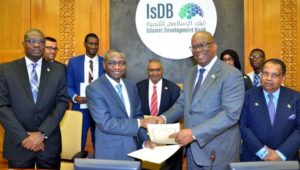Minister of Finance Winston Jordan and the Islamic Development Bank’s (IsDB) Vice President of Sector Operations Mansur Muhtar, on Wednesday, in Jeddah, signed a US$20M agreement for a loan that is expected to go towards the improvement of the country’s power supply through the Guyana Power and Light Incorporated (GPL Inc.).
It was outlined that the G$4.2B loan is part of the utility company’s Upgrade Programme, a component of its development and Expansion Programme for 2014 to 2021.
Describing the historic occasion as a celebration of the first loan to be granted, Finance Minister Winston Jordan posited that “It cemented our growing relationship and the proactive use of the indicative resource envelope for Guyana… [the loan agreement] incorporates necessary reforms and upgrades to reduce losses, and improve the quality and reliability of electricity supply and will, at the same time help to transform Guyana’s infrastructural landscape, boost our manufacturing sector and improve the quality of life of our citizens.”

Adding that the agreement could not have come at a more opportune time, the Finance Minister said “This was especially since, Guyana is on the cusp of a historic transformation with the recent discovery of over 4B barrels of oil.”
He further disclosed that the International Monetary Fund described Guyana’s medium-term economic prospects as “very favourable” and predicted GDP will grow by 29.1 per cent in 2020.
“The IMF has commended us on our “prudence and restraint towards borrowing in anticipation of future oil revenues”. As such, our public debt stood at a highly sustainable 52.2 per cent of GDP at the end-2017” said Jordan.
During the period 27-29 November 2017, the Islamic Development Bank’s (IsDB) mounted a mission to Guyana to develop a medium-term work plan for the period 2018-2022. That plan outlines a pipeline of projects that the bank can support over the next five years. The IsDB has a resource envelope of over $188B (US$900M) that is potentially available from which the government can source.
The potential areas of collaboration between the IsDB and the Government of Guyana cover several development sectors including agriculture, banking and finance, human development, energy and rural development.
Observers have contended however, that since the incumbent Administration came into power in 2015 the public debt has ballooned.
In fact, former President and Opposition Leader, Dr Bharrat Jagdeo had dubbed the revelation that Government had singled its intention to possibly borrow approximately 220 billion Guyana dollars (GuySuCo’s $30B bond and the Islamic Development Bank loan of $US 900M) as ‘shocking and cause for worry.’
Jagdeo an economist by profession had said that “this failed approach to national economic management was tried in the past. It led to a bankrupt country and resulted in devastating consequences for our people. I am sure everyone would recall that the external debt was over 900 per cent of GDP in 1992, which was reduced to 36 per cent of GDP in 2015.”
Moreover, he predicted that “this Government would go this route since the massive growth in the size of the national budgets, primarily on consumption, could not be financed by the hefty increase in taxation.”



